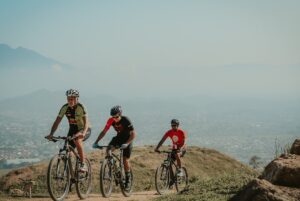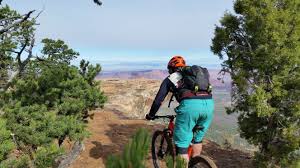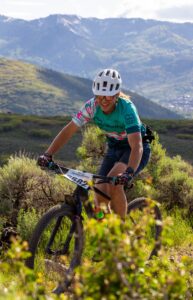Key Takeaways
-
Identifying user-friendly GPS mapping software is crucial for senior bikers to navigate trails safely.
-
Understanding trail features and difficulty ratings helps seniors choose the right paths for their skill level.
-
Preparation is key; seniors should gear up properly and be aware of their physical limits before hitting the trails.
-
Mountain biking offers significant mental and physical health benefits, making it an excellent activity for seniors.
-
Community building is important; connecting with fellow senior riders can enhance the overall experience.

To use GPS mapping software for mountain biking, you can follow these steps
-
Gaia GPS: Turn your phone into a cycling GPS with Gaia GPS. This app allows you to navigate offline, plan routes, track stats, and download maps for trails. You can view mountain biking trails on the OpenCycleMap, access forest service roads, foot trails, and more. Gaia GPS lets you record GPS tracks, store rides, and share them across devices1
-
Strava: While Strava is more focused on tracking rides, it offers route planning features. The web version provides a user-friendly interface for creating mountain biking routes by clicking on the map to add waypoints and fine-tune your route. You can search for addresses and landmarks to add to your route, adjust terrain preferences, view popular routes with the Global Heatmap, and save your routes for navigation on the app2
-
Trailforks: For detailed ride planning, Trailforks is an excellent choice. It provides extensive trail information like difficulty ratings (Green, Blue, Black), rider ratings, topographic layers, points of interest, trail popularity, heatmaps, routes, trail conditions, GPS tracking, Strava Segment Leaderboard integration, and more. Trailforks offers a wealth of data to plan your mountain bike rides effectively3
By utilizing these apps like Gaia GPS, Strava, and Trailforks, mountain bikers can enhance their riding experience by accessing detailed trail maps, planning routes efficiently, tracking performance metrics, and exploring new trails with ease.
Explore with Confidence: GPS Software for Senior Bikers
Mountain biking isn’t just for the young and reckless. It’s a sport that embraces the young at heart, regardless of the number of candles on their birthday cake. And with the right GPS mapping software, senior bikers can explore the trails with confidence. Let’s talk about how technology can be your ally, guiding you safely through the twists and turns of mountain biking adventures.
First, you’ll want a GPS tool that’s straightforward. Complexity isn’t your friend when you’re out on the trails. You need clear, easy-to-read maps and a user interface that doesn’t require a tech wizard to navigate. Some GPS software is designed with seniors in mind, featuring larger icons, audible turn-by-turn directions, and emergency features.
-
Look for GPS mapping software with a simple layout and intuitive controls.
-
Choose a system with a clear display that you can read in various lighting conditions.
-
Ensure the GPS includes features like easy route tracking, offline maps, and emergency location sharing.
Next, consider the software’s ability to update and display trail information. The last thing you want is to be led astray by outdated maps. A good GPS system for mountain biking will offer real-time updates and show you the latest trail conditions, closures, or detours.
Choosing the Right GPS Mapping Software
When selecting your GPS companion, think about compatibility. Does it sync with your smartphone? Can you load it onto a dedicated GPS device that mounts on your bike? You have options, and it’s essential to choose one that works best for you.
Also, consider whether you want additional features like heart rate monitoring or the ability to connect to other sensors on your bike. These can give you valuable insights into your fitness level and help you track your progress over time.
And remember, the best GPS is the one that you’ll actually use. So, pick one that feels right for you, and take some time to get to know it before you hit the trails. It’s an invaluable tool that not only guides you through the wilderness but also ensures you can always find your way back home.
“The journey of a thousand miles begins with a single pedal stroke, and the right GPS is your compass.” – An experienced senior biker
Navigating Trail Features and Difficulty Ratings
Understanding trail features is like knowing the language of the land. You’ll come across terms like ‘singletrack,’ ‘doubletrack,’ and ‘technical sections.’ Singletrack trails are narrow and meant for one-way travel. They can be winding and require a bit more skill. Doubletrack trails are wider, often easier, and suitable for two-way traffic. Technical sections refer to challenging parts of the trail that might include obstacles like roots, rocks, or steep grades.

Trail difficulty ratings are there to help you gauge whether a trail is within your comfort zone. They’re often color-coded, similar to ski slopes, ranging from green for easy, to blue for intermediate, all the way to black for difficult. These ratings take into account the trail’s surface, gradient, and technical features. For more on navigating these trails, check out our guide on mountain biking trails.
-
Green trails are your go-to for a leisurely ride with minimal obstacles.
-
Blue trails offer a step up with moderate climbs and descents and some technical features.
-
Black trails are for experienced riders, with steep terrain and complex technical challenges.
As a senior biker, pay close attention to these ratings. They’re not just suggestions; they’re there to ensure you enjoy your ride and return safely. Always start with easier trails and work your way up as you gain confidence and skill. For more insights, check out this article on the health benefits of mountain biking for seniors.
Essential Safety Gear and Checks
Before you venture out, gear up for safety. This is non-negotiable. A well-fitting helmet is your first line of defense against head injuries. Gloves will protect your hands and improve grip. And don’t forget eyewear to shield your eyes from dust and debris. But gear is only as good as its condition, so inspect it before each ride. Look for cracks in your helmet and ensure your bike’s brakes and tires are in top shape.
Another piece of gear to consider is a high-visibility vest or clothing with reflective materials. Being easily seen is especially important if your trail crosses roads or is used by other bikers and hikers. And for those longer rides, a GPS with a long battery life and a portable charger can be a lifesaver.
Lastly, always check the weather before you head out. Sudden changes in weather can make trails dangerous and navigation more challenging. With your gear checked and weather-appropriate clothing, you’re all set for a safer ride.
Understanding and Respecting Your Limits
Know your limits. It’s not just sage advice; it’s a rule to ride by. If you’re new to mountain biking or getting back into it, start with shorter, less challenging trails. Pay attention to how your body feels during and after rides. If you’re feeling pain or exhaustion, it’s time to take a break. Pushing too hard can lead to injuries, which can keep you off the bike for longer than you’d like. For more information on how to get started, check out this guide to mountain biking for seniors.
MTB Project and Trailforks are two popular GPS mapping software options for mountain bike trails
MTB Project offers a comprehensive guide with offline maps, GPS route info, elevation profiles, interactive features, and photos, covering over 77,000 miles of trails. The app allows you to download trails for offline use and syncs with your to-do list on MTBProject.com12
On the other hand, Trailforks provides a trail database and maps for mountain biking enthusiasts3
For those interested in exploring regional trails and bikeways, the MARC Regional Trails & Bikeways Map is a valuable resource5
Additionally, if you are looking to find and navigate mountain bike trails in your area, there are informative videos available on platforms like YouTube4
Staying Active: The Joy of Ageless Exploration
Mountain biking isn’t just about the thrill of the ride; it’s about the joy of exploration at any age. It’s a way to stay active, to challenge yourself, and to see the world from a new perspective. Whether you’re cruising through a forest trail or tackling a rugged mountain path, every ride is an opportunity for discovery.
Mental and Physical Benefits of Mountain Biking
Mountain biking is a complete workout. It builds strength, improves cardiovascular health, and boosts your balance and coordination. The mental benefits are just as significant. Riding through nature can reduce stress, enhance mood, and improve cognitive function. It’s an all-around win for your well-being.
Building a Community of Senior Riders
One of the best parts of mountain biking is the community. Joining a group of senior riders can provide camaraderie, motivation, and shared knowledge. It’s also a chance to learn from others and perhaps even mentor new riders. You can find local groups through bike shops, community centers, or online platforms like Meetup.
When you ride with others, you share the experience. You can encourage each other, share tips and tricks, and make memories together. Plus, it’s always good to have someone with you in case of an emergency.
And remember, community isn’t just about riding together. It’s also about advocating for safe, accessible trails and promoting the sport among seniors. By building a community, you’re not just enjoying the trails; you’re helping to ensure they’ll be there for future generations of senior riders.
“The sense of community among senior mountain bikers is as inspiring as the ride itself. It’s about sharing the journey, not just the trail.” – A seasoned rider
Step-By-Step: Planning Your Mountain Biking Adventure
Now, let’s get down to planning your adventure. Start by choosing your trail. Use your GPS mapping software to find trails that match your skill level and preferences. Look at the elevation profile, distance, and difficulty rating. Then, set your route, noting any points of interest or rest spots.
How to Use your GPS for Trail Planning
-
Search for trails in your desired area using the GPS app or website.
-
Check user reviews and recent activity for current trail conditions.
-
Download the trail map to your device for offline use.
-
Mark waypoints for important locations like water sources, scenic views, or steep sections.
-
Set up emergency contacts on your device and share your planned route with them.
Once your route is set, it’s time to prepare your gear. Pack a small repair kit with essentials like a multi-tool, spare tube, and a hand pump. And don’t forget your first aid kit. Even minor scrapes or blisters can turn a great ride into an uncomfortable experience.
Hydration and nutrition are just as important as your bike and helmet. Bring plenty of water and snacks that are easy to eat on the go. Foods high in protein and complex carbohydrates will give you sustained energy for the ride.
And finally, make sure your phone is fully charged and that you have a backup power source. A portable battery pack can be a lifesaver if your GPS or phone runs low on power.
Planning is essential, but so is flexibility. Be prepared to adjust your route if you encounter unexpected trail conditions or if you’re feeling more fatigued than usual. The goal is to enjoy the ride, not just to reach the end.
By following these steps, you’re setting yourself up for a successful and enjoyable mountain biking adventure. And with each ride, you’ll gain more experience and confidence, which will make planning your next outing even easier.
Packing Essentials for a Day on the Trails
Let’s pack for success. Here’s what you should bring for a day on the trails:
-
A well-fitting helmet and gloves for protection.
-
High-visibility clothing or accessories to ensure you’re seen.
-
Waterproof and weather-appropriate clothing to stay comfortable.
-
A repair kit with a multi-tool, spare tube, and hand pump for quick fixes.
-
A first aid kit for minor injuries.
-
Plenty of water to stay hydrated and snacks for energy.
-
Your phone, fully charged, with a portable charger as a backup.
With these essentials packed, you’re ready to hit the trails. Remember, the aim is to have fun and enjoy the beauty of the outdoors. So gear up, plan well, and embrace the adventure that awaits.

FAQ About Senior Mountain Biking
Now, let’s address some common questions you might have about senior mountain biking. It’s natural to have concerns and curiosities, especially if you’re new to the sport or coming back after a break. So, let’s dive in.
Is mountain biking safe for seniors?
Absolutely, mountain biking can be a safe and rewarding activity for seniors. It’s all about choosing the right trails, having the proper equipment, and listening to your body. Start with easier trails and gradually build up your strength and confidence.
It’s also wise to ride with a friend or in a group, especially when you’re just starting out. This way, you have someone to help you navigate the trails and assist in case of an emergency. And always make sure to inform someone about your biking plans and expected return time.
Remember to carry your mobile phone with a fully charged battery and have your GPS device with you. These tools can help you call for help if needed and ensure you stay on the right path.
-
Start with trails suited to your fitness level and experience.
-
Wear the appropriate safety gear, including a helmet and gloves.
-
Carry a communication device and inform others of your plans.
Can I start mountain biking if I’ve never done it before?
Of course! It’s never too late to start mountain biking. The key is to begin slowly and give yourself time to learn and adapt. Consider taking a beginner’s class to get comfortable with the basics, such as how to handle your bike, navigate different terrains, and perform simple repairs.
When you’re starting, it’s important to choose a bike that’s comfortable and fits you well. Visit your local bike shop for advice and consider renting different types of bikes to find what suits you best. And most importantly, have fun and enjoy the learning process!
What should I do if I get lost on the trail?
If you find yourself disoriented on the trail, don’t panic. The first step is to stop and assess your situation. Check your GPS device for your current location and try to retrace your steps to a familiar point on the trail. If you’re using a smartphone, apps like Gaia GPS can show you where you are and how to get back on track.
If you’re still lost, stay where you are and call for help using your phone. It’s crucial to conserve your battery life, so only use your phone when necessary. Always tell someone where you’re going before you head out, so they can alert authorities if you don’t return as expected.
How do I find mountain biking groups for seniors?
Finding a community of senior mountain bikers is easier than you might think. Start by checking local bike shops and community centers for group rides and events. Online platforms like Meetup.com are also great resources for finding local biking groups.
Additionally, consider joining biking forums and social media groups where you can connect with other riders. Not only will you find companionship, but you’ll also learn from the experiences of others. Riding with a group can significantly enhance your mountain biking experience.
What are the best GPS devices for mountain biking?
When it comes to choosing a GPS device for mountain biking, there are several options to consider:
The Garmin Edge series is popular among cyclists for its robust features and reliable performance. These devices offer detailed maps, turn-by-turn navigation, and performance tracking.
For those who prefer using their smartphone, apps like Strava and Trailforks offer GPS tracking and social features that allow you to share your rides and explore new trails. Make sure your phone is equipped with a durable case and a handlebar mount for easy access.
Another option is the Wahoo ELEMNT, which provides a user-friendly interface and seamless integration with other fitness devices. It’s a solid choice for those who want to keep their rides simple and focused.
Ultimately, the best GPS device is one that suits your specific needs and preferences. Consider factors like battery life, display readability, and ease of use when making your decision.
Remember, the most important thing is to get out there, enjoy the trails, and explore the world on two wheels. Happy riding!
As the popularity of outdoor activities among older adults continues to rise, mountain biking is seeing a significant uptick in interest from the senior community. With advancements in senior-friendly e-bikes and gear, more seniors are hitting the trails to enjoy the health benefits and the thrill of the ride. Mountain biking offers a great way to explore nature, get some exercise, and challenge oneself, regardless of age.


